Abstract
Two immunotoxins were constructed by chemically coupling the monoclonal antibody C242 to Pseudomonas exotoxin A (PE) or a modified form, NlysPE40, that lacks the cell binding domain of PE. Monoclonal antibody C242 recognizes a specific sialylated carbohydrate epitope on a high molecular weight membrane glycoprotein present on cells of human colon, pancreatic, and cervical cancers. C242-PE and C242-NlysPE40 were very cytotoxic for cells expressing this antigen with 50% inhibition of protein synthesis occurring on Colo205 cells at 0.2 ng/ml (0.9 pM) for C242-PE and 6.0 ng/ml (31 pM) for C242-NlysPE40. The two immunotoxins also exhibited a strong antitumor effect on a human colon cancer xenograft grown in nude mice. The specificity and potency of these two C242 immunotoxins warrant their further development for the treatment of cancer.
Full text
PDF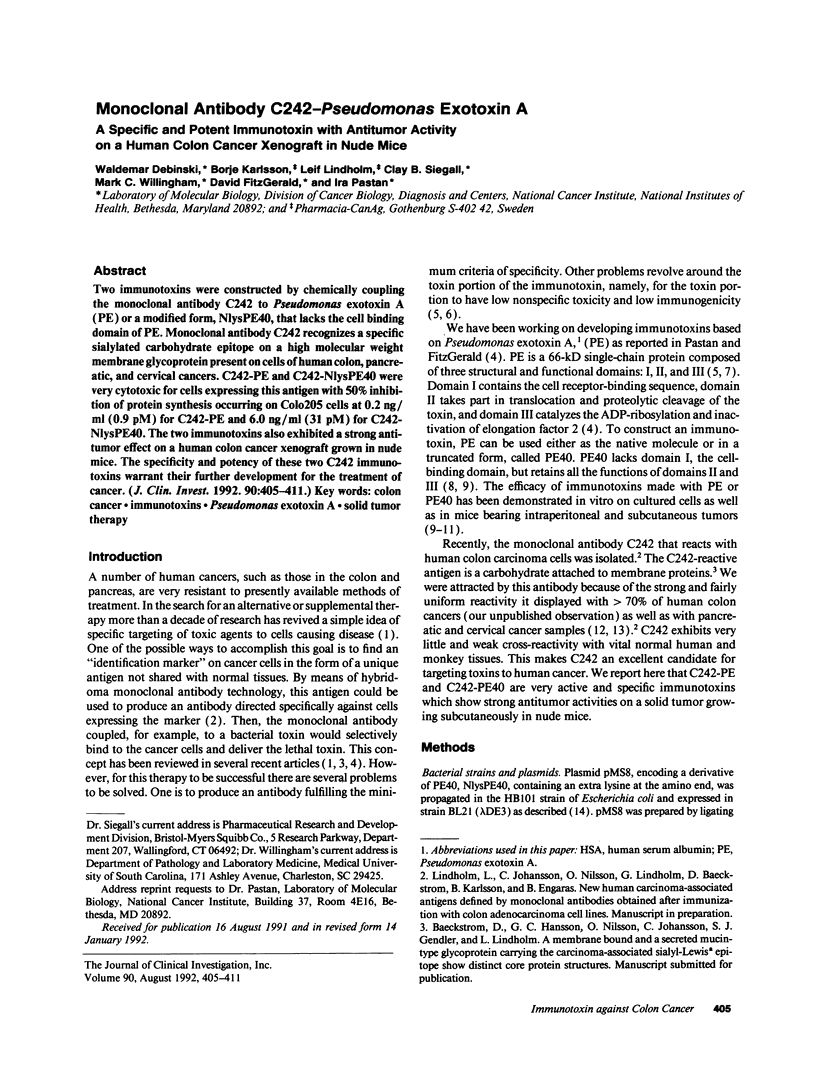

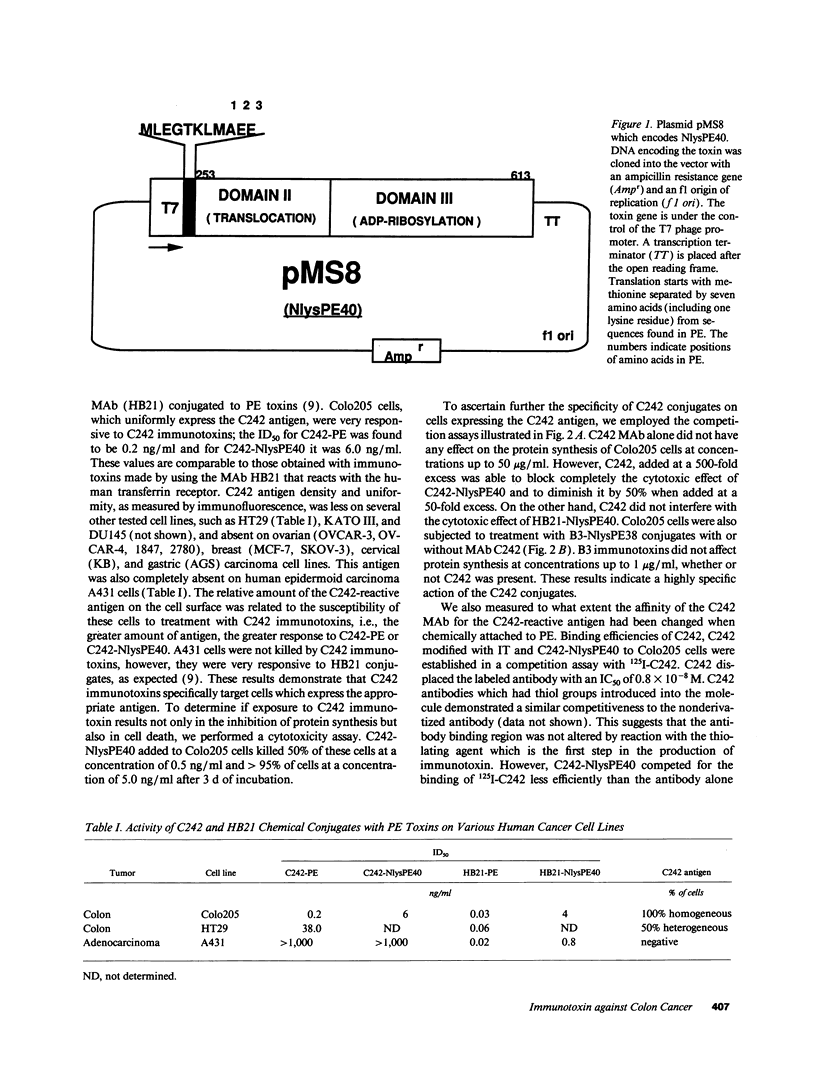
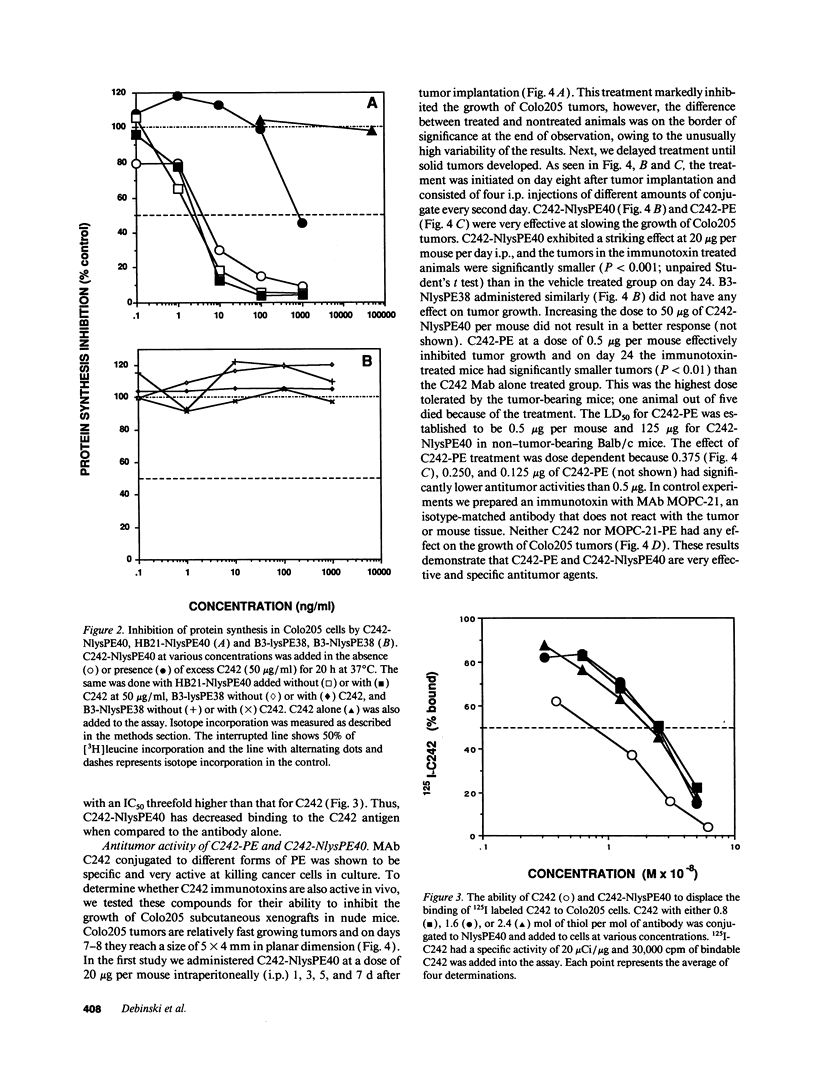
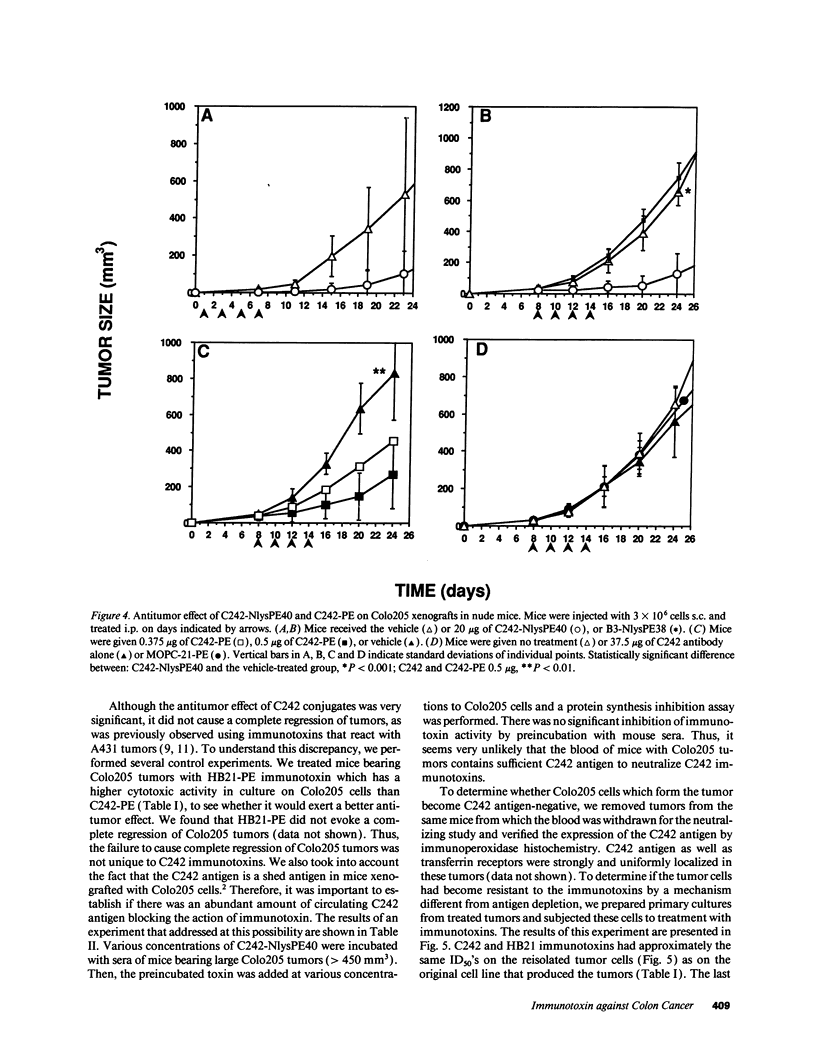
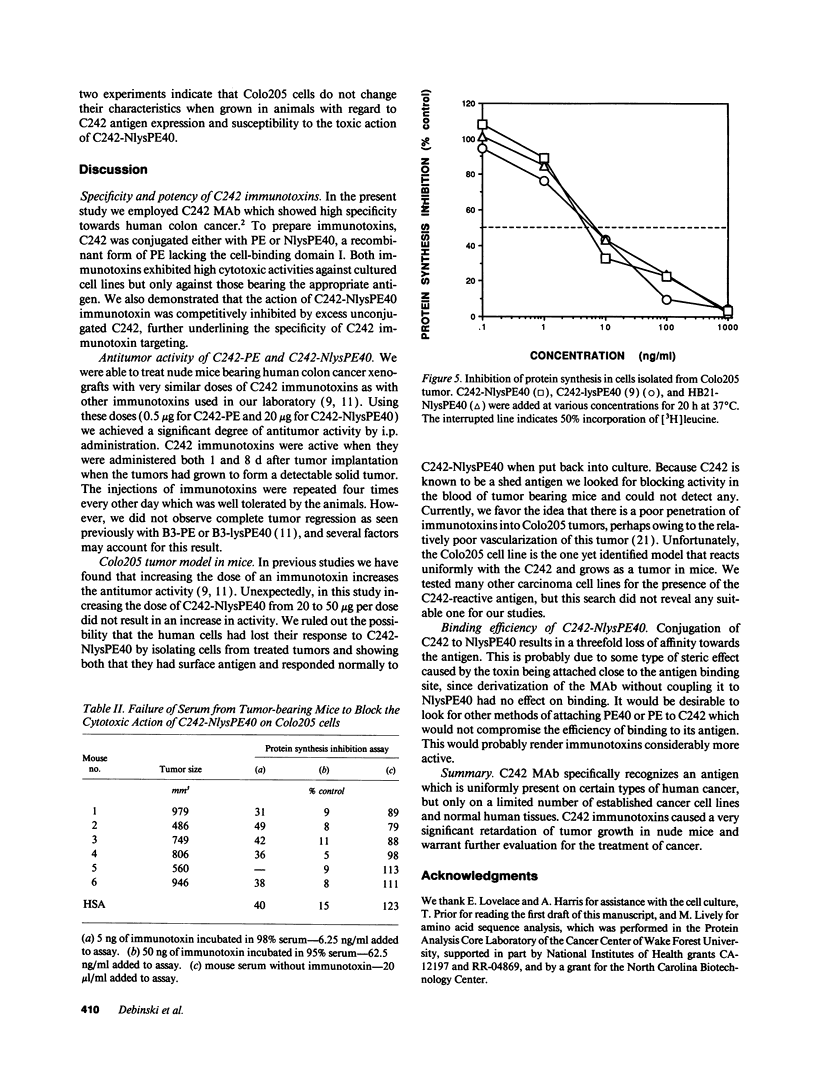
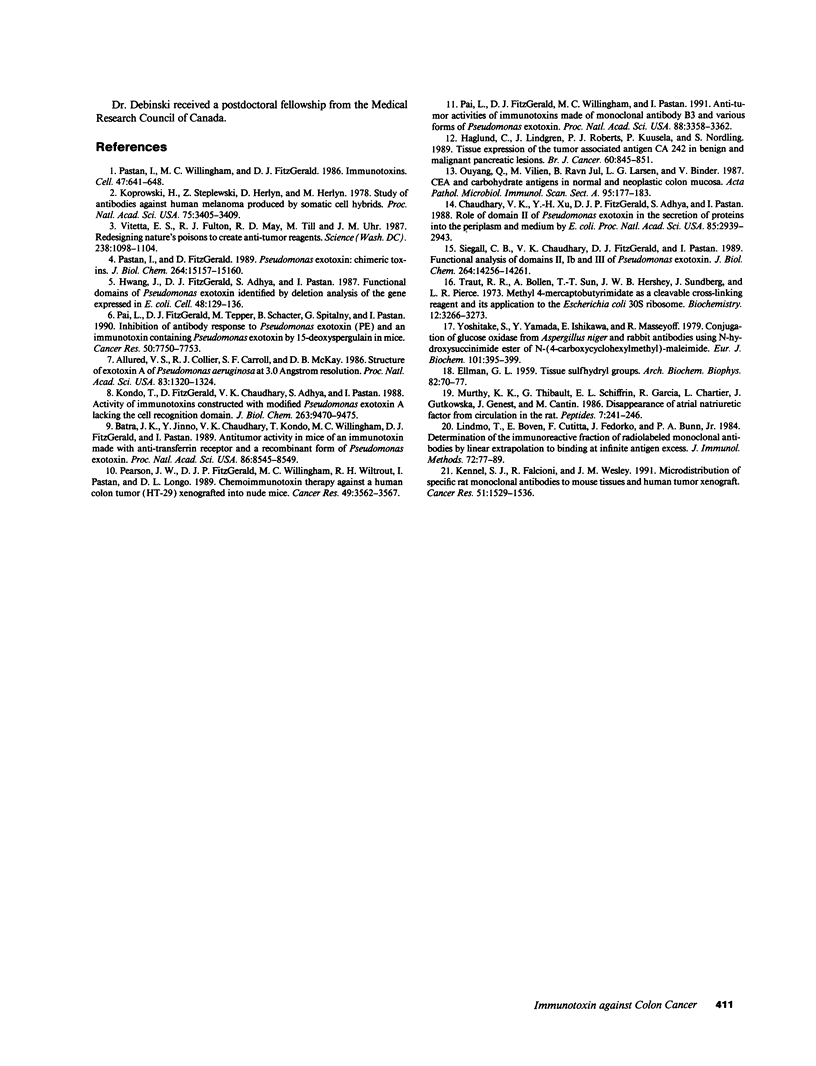
Selected References
These references are in PubMed. This may not be the complete list of references from this article.
- Allured V. S., Collier R. J., Carroll S. F., McKay D. B. Structure of exotoxin A of Pseudomonas aeruginosa at 3.0-Angstrom resolution. Proc Natl Acad Sci U S A. 1986 Mar;83(5):1320–1324. doi: 10.1073/pnas.83.5.1320. [DOI] [PMC free article] [PubMed] [Google Scholar]
- Batra J. K., Jinno Y., Chaudhary V. K., Kondo T., Willingham M. C., FitzGerald D. J., Pastan I. Antitumor activity in mice of an immunotoxin made with anti-transferrin receptor and a recombinant form of Pseudomonas exotoxin. Proc Natl Acad Sci U S A. 1989 Nov;86(21):8545–8549. doi: 10.1073/pnas.86.21.8545. [DOI] [PMC free article] [PubMed] [Google Scholar]
- Chaudhary V. K., Xu Y. H., FitzGerald D., Adhya S., Pastan I. Role of domain II of Pseudomonas exotoxin in the secretion of proteins into the periplasm and medium by Escherichia coli. Proc Natl Acad Sci U S A. 1988 May;85(9):2939–2943. doi: 10.1073/pnas.85.9.2939. [DOI] [PMC free article] [PubMed] [Google Scholar]
- ELLMAN G. L. Tissue sulfhydryl groups. Arch Biochem Biophys. 1959 May;82(1):70–77. doi: 10.1016/0003-9861(59)90090-6. [DOI] [PubMed] [Google Scholar]
- Haglund C., Lindgren J., Roberts P. J., Kuusela P., Nordling S. Tissue expression of the tumour associated antigen CA242 in benign and malignant pancreatic lesions. A comparison with CA 50 and CA 19-9. Br J Cancer. 1989 Dec;60(6):845–851. doi: 10.1038/bjc.1989.377. [DOI] [PMC free article] [PubMed] [Google Scholar]
- Hwang J., Fitzgerald D. J., Adhya S., Pastan I. Functional domains of Pseudomonas exotoxin identified by deletion analysis of the gene expressed in E. coli. Cell. 1987 Jan 16;48(1):129–136. doi: 10.1016/0092-8674(87)90363-1. [DOI] [PubMed] [Google Scholar]
- Kennel S. J., Falcioni R., Wesley J. W. Microdistribution of specific rat monoclonal antibodies to mouse tissues and human tumor xenografts. Cancer Res. 1991 Mar 1;51(5):1529–1536. [PubMed] [Google Scholar]
- Kondo T., FitzGerald D., Chaudhary V. K., Adhya S., Pastan I. Activity of immunotoxins constructed with modified Pseudomonas exotoxin A lacking the cell recognition domain. J Biol Chem. 1988 Jul 5;263(19):9470–9475. [PubMed] [Google Scholar]
- Koprowski H., Steplewski Z., Herlyn D., Herlyn M. Study of antibodies against human melanoma produced by somatic cell hybrids. Proc Natl Acad Sci U S A. 1978 Jul;75(7):3405–3409. doi: 10.1073/pnas.75.7.3405. [DOI] [PMC free article] [PubMed] [Google Scholar]
- Lindmo T., Boven E., Cuttitta F., Fedorko J., Bunn P. A., Jr Determination of the immunoreactive fraction of radiolabeled monoclonal antibodies by linear extrapolation to binding at infinite antigen excess. J Immunol Methods. 1984 Aug 3;72(1):77–89. doi: 10.1016/0022-1759(84)90435-6. [DOI] [PubMed] [Google Scholar]
- Murthy K. K., Thibault G., Schiffrin E. L., Garcia R., Chartier L., Gutkowska J., Genest J., Cantin M. Disappearance of atrial natriuretic factor from circulation in the rat. Peptides. 1986 Mar-Apr;7(2):241–246. doi: 10.1016/0196-9781(86)90220-2. [DOI] [PubMed] [Google Scholar]
- Ouyang Q., Vilien M., Juhl B. R., Larsen L. G., Binder V. CEA and carbohydrate antigens in normal and neoplastic colon mucosa. An immunohistochemical study. Acta Pathol Microbiol Immunol Scand A. 1987 Jul;95(4):177–183. doi: 10.1111/j.1699-0463.1987.tb00028_95a.x. [DOI] [PubMed] [Google Scholar]
- Pai L. H., Batra J. K., FitzGerald D. J., Willingham M. C., Pastan I. Anti-tumor activities of immunotoxins made of monoclonal antibody B3 and various forms of Pseudomonas exotoxin. Proc Natl Acad Sci U S A. 1991 Apr 15;88(8):3358–3362. doi: 10.1073/pnas.88.8.3358. [DOI] [PMC free article] [PubMed] [Google Scholar]
- Pai L. H., FitzGerald D. J., Tepper M., Schacter B., Spitalny G., Pastan I. Inhibition of antibody response to Pseudomonas exotoxin and an immunotoxin containing Pseudomonas exotoxin by 15-deoxyspergualin in mice. Cancer Res. 1990 Dec 15;50(24):7750–7753. [PubMed] [Google Scholar]
- Pastan I., FitzGerald D. Pseudomonas exotoxin: chimeric toxins. J Biol Chem. 1989 Sep 15;264(26):15157–15160. [PubMed] [Google Scholar]
- Pastan I., Willingham M. C., FitzGerald D. J. Immunotoxins. Cell. 1986 Dec 5;47(5):641–648. doi: 10.1016/0092-8674(86)90506-4. [DOI] [PubMed] [Google Scholar]
- Pearson J. W., FitzGerald D. J., Willingham M. C., Wiltrout R. H., Pastan I., Longo D. L. Chemoimmunotoxin therapy against a human colon tumor (HT-29) xenografted into nude mice. Cancer Res. 1989 Jul 1;49(13):3562–3567. [PubMed] [Google Scholar]
- Siegall C. B., Chaudhary V. K., FitzGerald D. J., Pastan I. Functional analysis of domains II, Ib, and III of Pseudomonas exotoxin. J Biol Chem. 1989 Aug 25;264(24):14256–14261. [PubMed] [Google Scholar]
- Traut R. R., Bollen A., Sun T. T., Hershey J. W., Sundberg J., Pierce L. R. Methyl 4-mercaptobutyrimidate as a cleavable cross-linking reagent and its application to the Escherichia coli 30S ribosome. Biochemistry. 1973 Aug 14;12(17):3266–3273. doi: 10.1021/bi00741a019. [DOI] [PubMed] [Google Scholar]
- Vitetta E. S., Fulton R. J., May R. D., Till M., Uhr J. W. Redesigning nature's poisons to create anti-tumor reagents. Science. 1987 Nov 20;238(4830):1098–1104. doi: 10.1126/science.3317828. [DOI] [PubMed] [Google Scholar]
- Yoshitake S., Yamada Y., Ishikawa E., Masseyeff R. Conjugation of glucose oxidase from Aspergillus niger and rabbit antibodies using N-hydroxysuccinimide ester of N-(4-carboxycyclohexylmethyl)-maleimide. Eur J Biochem. 1979 Nov;101(2):395–399. doi: 10.1111/j.1432-1033.1979.tb19731.x. [DOI] [PubMed] [Google Scholar]


